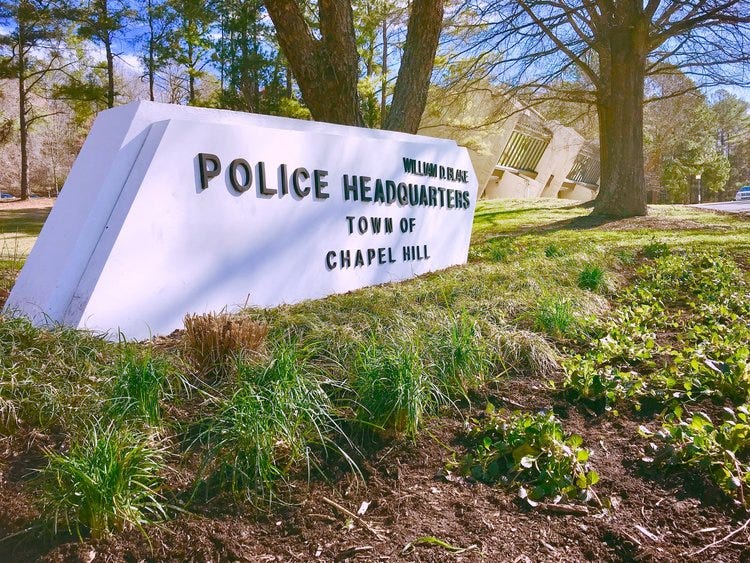
“Viewpoints” is a place on Chapelboro where local people are encouraged to share their unique perspectives on issues affecting our community. If you’d like to contribute a column on an issue you’re concerned about, interesting happenings around town, reflections on local life — or anything else — send a submission to viewpoints@wchl.com.
The Future of 828 MLK Boulevard
A perspective from Karen Stegman
828 MLK Boulevard is the current home of the Chapel Hill Police Department. The police department building is aging, substandard, and too small for the current needs of the department. The need to address this has been made more challenging by the 2013 discovery of coal ash at the site. That finding sparked a nine-year process to date to evaluate the site and determine the best ways to minimize the effects of coal ash on human and environmental health.
But it is difficult to talk about the environmental remediation and redevelopment of the Chapel Hill Police Department site without addressing the destructive pattern of misinformation we see, once again, being spread in our community. I’m sorry to say that this isn’t new. In a previous blog post, I talked about the “othering” of our local government and of those who serve in it – campaigns designed to sow mistrust and suspicion by misrepresenting the decisions made and the motives behind them. This is harmful to the fabric of our community, and it is playing out once again.
We see this taking place right now with 828 MLK Blvd. There has been a significant amount of intentional misinformation shared with the public via Next Door and social media about the project by a small group of community members and one Council Member. This misinformation campaign is designed to undermine trust in local government and create anger and fear, rather than to inform and educate about a complex topic. In this post, I will correct some of the misconceptions currently circulating and outline how the Town is approaching decisions related to the project.
First, a note on transparency
The current Council, like previous ones dating back to 2013, has been studying this site extensively and with full transparency. The town’s website created for this project details the full history of the project, all of the studies that have taken place along with their results and next steps, and offers a full timeline and detailed analysis of the project site.
There has been nothing rushed about this process. It has been slow, painstaking, and cautious, stretching over almost nine years of studies, consultation, and expert review, working closely with respected environmental experts in this field, such as Hart Hickman. The Council has followed an exacting, measured, and stepwise process for each decision about the future of this site.
And an important note about safety
WHile I can only speak for myself, I feel certain that the Mayor, my Council colleagues, and Town staff will not support residential construction at 828 MLK without proper remediation that eliminates exposure.
Now, let’s talk about the 828 site
Before I talk about remediation, I want to be clear about the makeup of the 828 site. It is not a coal ash pond or a coal ash dump. It is not slurry that can leak into waterways. And it is not comparable to the Duke Energy unlined basin sites around the state that have made headlines in recent years. In short, it is different from the types of coal ash sites that have been the subject of case studies about the dangers of coal ash to human health. It is also very different from other sites that many folks have read about in that it contains no volatile chemicals that can escape into the environment.
Instead, the coal ash at the 828 site is a solid that has been in place for about 50 years. At the time, coal ash was used in many construction projects as structural fill. The police station site contains coal ash mixed with other construction debris in a covered pit on site.
For the past three years, we have implemented temporary remediation measures designed to ensure that employees at the police station and users of the Bolin Creek trail nearby are protected. The environmental specialists who have examined the site have concluded that the temporary mediation measures have mitigated risk to nearby users in the short term while we determined the longer-term solution. They also determined that we can make the site safe for long-term use by leaving the more deeply buried coal ash in place, removing any coal ash at the surface and subsurface, and capping those areas with clean soil, buildings, and pavement so they cannot be interrupted.
Along with the remediation of the coal ash that will take place, new stormwater infrastructure, a retaining wall, and other updates to the site will direct water flow away from Bolin Creek and minimize runoff that could erode soil covering. The NC Department of Environmental Quality (DEQ) requires regular inspections to ensure that if any issues did occur, they would be identified and addressed.
Entering a Brownfields agreement helps ensure safety
In 2021, the Council voted to move forward with entering into a Brownfields Program operated by DEQ. This is a voluntary but rigorous program designed to ensure that any redeveloped site is completely safe for the purpose being considered. Wegman’s is a Brownfield site. As part of the Wegman’s site development, for example, the land-use agreement for the project stipulates that any landscaping cannot exceed a depth of twenty-four inches.
Because of how DEQ and Brownfield rules work, we need to have at least a draft development plan in order to assess the feasibility and safety of construction and develop a specific remediation plan. This is required to ensure that whatever we build will be safe for workers, residents, and passersby. This includes consideration of the impact of climate change, storm intensity, etc. In other words, in order to assess the safety of any proposed plan, we must have a plan to assess! Creating a draft development plan does not mean all development will necessarily go forward. It means that the Council is taking the necessary steps to ensure that any development is safe for all.
Again, the Council will not support any development that cannot be made safe for everyone. Similar to the Wegman’s site, a comprehensive land-use restriction will be put in place with DEQ to ensure the safety of human and environmental health. Any proposed plans for development of the site will be accompanied by a stringent remediation plan enforced by DEQ that includes regular inspections, monitoring, and mitigations for the life of the development.
What is in the proposed concept for development?
Currently, we plan to build a new Municipal Services Center to replace the current police headquarters. This building would provide office space for the police department as well as certain other town departments. Aside from the Municipal Services Center, no decisions have yet been made about what else will be built on the site and there are many more steps that will stretch over a year or more before a final decision is reached. Regardless of what housing is or is not built on the site, we will have police and other Town staff working there so we are unquestionably committed to ensuring the site is safe for all who use it.
We plan to explore housing on the site, but only if it’s safe
We have a housing crisis in this country and in this town, as skyrocketing purchase and rental prices have demonstrated. We need more housing, and – If it can be made safe – this would be a terrific location to put it. It is on a bus line, in the middle of town, and along the wonderful Bolin Creek greenway. Additionally, we are committed to a significant portion of any housing built being affordable to public workers.
Why not remove all of the coal ash?
Some are advocating for complete removal of all coal ash from the site. Apart from the prohibitive cost (current estimate ~$16 million) and health risks of digging up and transporting an estimated 5,000 truckloads of coal ash through town and through the state, risking coal ash becoming air borne during transport, it is important to ask where that coal ash would go, because it must go somewhere. Full removal would require dumping this hazard on another community – one that economically has no choice but to accept truckloads of coal ash. These landfills are located primarily in low-income areas and/or communities of color so it is important to reflect on this question of environmental justice before making such a decision. The Council is deeply concerned about the harm we could do and is factoring in the impact on other communities of color in this decision.
A note on racial equity
This Council is keenly aware of the racial and at times racist history of Chapel Hill. Many members felt called to serve specifically to represent historically marginalized residents and address past and current inequities that continue to impact residents to this day. The Council consists of three people of color – one whose family has lived in Northside for generations, one who has personally experienced housing insecurity, and one whose family members are first generation immigrants to this country. The fact that part of the false narrative about 828 MLK being circulated invokes the Rogers Road community and implies that this Council doesn’t care about or is acting to do harm to the African American community is deeply troubling and points to a need for deeper reflection on the role of white privilege in this debate.
Next steps and final thoughts
There is a public information meeting with DEQ scheduled for May 16 at 6pm via Zoom. Along with the many reports, studies, and documents on the Town website, this is a great opportunity to learn more.
Finally, for those who follow the Town Council closely (I know there are a few of you!), you know that while we mostly share core values, there is a diversity of opinion and prioritization that means Council Members often come down on different sides of any particular issue. In the case of 828 MLK, eight of the nine of us agree on the path we are taking because it has been thoughtful, thorough, guided by experts, and prioritizes the health and safety of our community. Being the lone dissenter doesn’t make you a folk hero. In this case, it reflects a lack of the humility required to approach public service with an open mind and a lack of trust in the community to reach its own conclusions when armed with facts.
“Viewpoints” on Chapelboro is a recurring series of community-submitted opinion columns. All thoughts, ideas, opinions and expressions in this series are those of the author, and do not reflect the work or reporting of 97.9 The Hill and Chapelboro.com.



Well said.
Thank you for this thoughtful explanation that also repudiates those who are intentionally detracting from legitimate efforts to benefit the community. I wish you and the town council the best of luck as the plan moves forward.